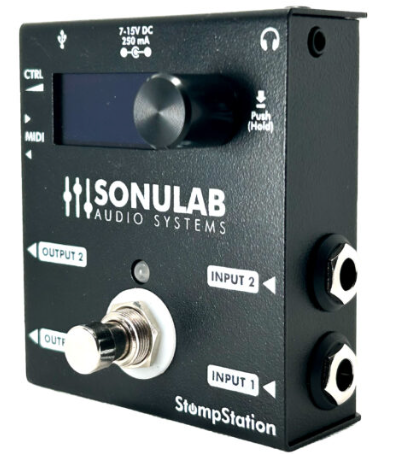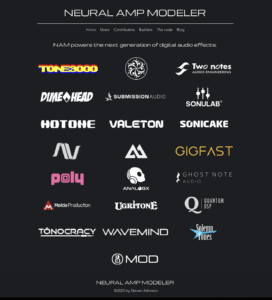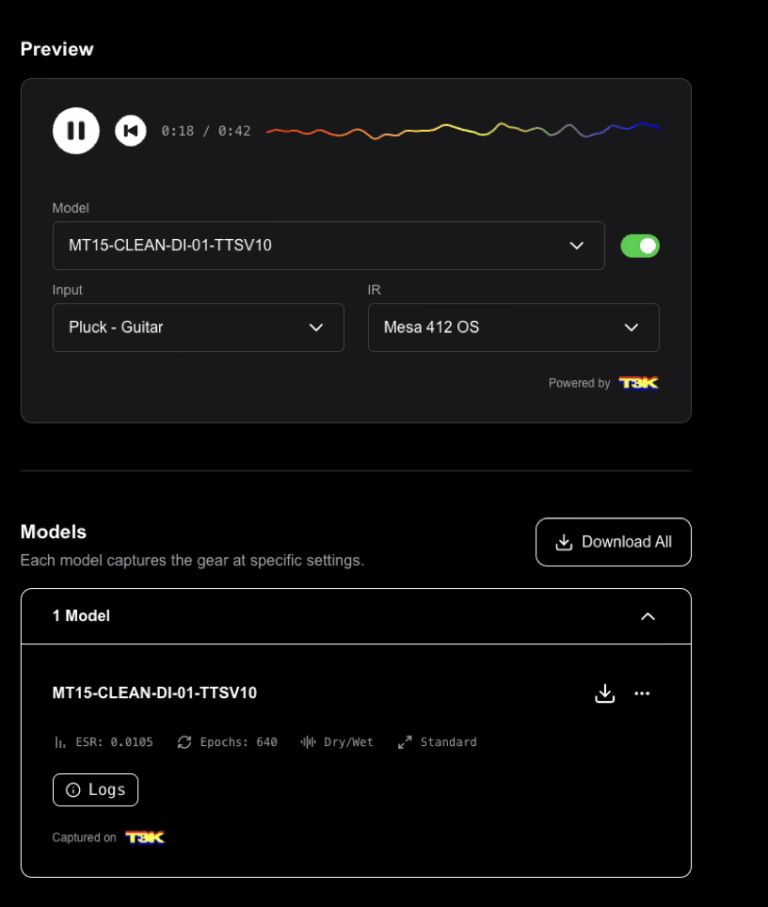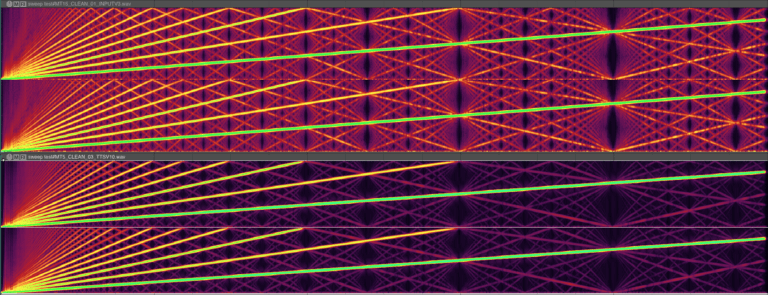Neural Amp Modeler (NAM), the AI-powered amp and gear modeling system created by Steve Atkinson, continues its steady evolution. The ecosystem is growing, and this post offers an overview of recent updates—both to the system itself and to the software and hardware now compatible with NAM models.
System & Plugin: What’s New
My last review of NAM dates back to May 2023, based on plugin version 0.7.3 (which was released May 12, 2023). Since then, the plugin has seen 10 updates, with the latest being version 0.7.13 released in December 2024.
The model training system has also evolved significantly—from version 0.5.2 (April 27, 2023) to version 0.12, across 15 updates.
You can access the plugin and modeler repos here :
Quick Recap: How NAM Works
As a reminder, the general workflow for creating and using a NAM model goes like this:
- Re-amp a reference audio file using your gear (amp only, pedal, amp+cab, or other hardware).
- Train the model, either:
- Locally (using Python and the NAM modeler)*,
- Through a Google Colab workspace (link here), or
- On tone3000.com (see T3K section below).
- Load the model using:
- The NAM standalone app,
- The NAM plugin in your DAW,
- Or third-party platforms like Two-Notes Genome.
While custom input files are supported, it’s recommended to retain the intro and outro from the standard input file. The modeler expects specific signal markers to ensure accurate calibration.
Note (*): two modeler options exist for local use: a GUI version and a CLI (command line) version. A GPU (such as an NVIDIA card) is strongly recommended.
Key System Improvements (Beyond Bug Fixes)
Here is a summary of major enhancements:
- Addition of calibration metadata: lets users and plugins adjust gain levels to better match the source gear or the model creator’s settings
- Introduction of V3 training files and robust file hash recognition
- Expanded metadata storage (e.g., sample rate now recorded in models)
- Support for Proteus training files
- Pre-training checks to flag input issues before processing
- Compatibility with non-24-bit/48kHz training files
So, the plugin now includes three output modes:
- Raw: untouched model output
- Normalized: NAM-standard volume
- Calibrated: uses model’s embedded calibration data (if available)

Steve Atkinson has documented the approach for calibration and provides advices on the NAM documentation site : https://neural-amp-modeler.readthedocs.io/en/latest/tutorials/calibration.html
NAM-Compatible Hardware & Software
The list of gear that can load or convert NAM models keeps growing. Some support NAM natively, others through conversion:
Hardware highlights:
- Dimehead guitar loader (native)
- Anagram by Darkglass for bass (native)
- Hotone Ampero II, Valeton GP-200, Valeton GP-5, Sonicake Pocketmaster, and Sonicake Matribox II (via conversion)
- Sonulab Stomptstation (conversion)
- PolyEffects Ample (NAM models preloaded)
And interestingly, Line6 has hinted at possible open-source model support for the Helix Stadium—though nothing is confirmed yet.

Software highlights:
- Sophisticated NAM-compatible players like WaveMind (unreviewed) and Tonocracy—akin to Genome by Two-Notes
- Plugins that use NAM under the hood (closed-source implementations)
- Paid model collections from third-party developers
A growing list of these companies and tools is available on the official NAM site: https://www.neuralampmodeler.com/

Tone3000.com (a.k.a “T3K”)
The community site formerly known as tonehunt.org wad relaunched in December 2024 as tone3000.com. The platform is thriving, with over 90,000 NAM models and 1.3 million downloads as of June 2025 (Source).
Key Updates on T3K:
- Built-in web player for instant previewing of NAM models and IRs
- Online model training with GPU support
- Better Tone Pack tools: add/edit models, upload promo images, tag links, refined filters
- Faster hosting and site performance
- Developer APIs for integration in plugins/apps
- Paid subscriptions coming for batch uploads and model training
- Upcoming T3K plugin to load models directly from the platform (probably similar to Tonex plugin/Tone.net)
- T3K was involved in launching Darkglass Anagram
Training Models on T3K
As mentioned earlier in this article, Tone3000 now allows you to calculate your models online, and you will have the option to share them or not: there is a private/public toggle switch on the collection for this.
Uploading and training models on T3K is simple:
- Upload input and reamped files
- Enter metadata
- Choose your settings
- The system queues your model for training, then it shows real-time progress bars and logs during processing
- Once completed, you can download your model and decide whether to keep it public or private
The screen below shows a custom model calculated on T3K, with a preview of the result:

Community power: NAM “HD” Models & Anti-Aliasing
One of the major advantages of open source—and free—solutions is that they generate significant interest and generate significant momentum. This is the case for users passionate about the NAM system, who invest a lot of time in experimentation and are responsible for some very interesting improvements. Since the model is open, it is possible to specify the NAM system’s learning network parameters as well as the different layers desired in the calculated model, which impacts their complexity and accuracy.
This approach was used by the system’s designer to offer models that are simpler and less CPU-intensive than the standard NAM model (these are the Lite, Feather, and Nano models).
But some users have gone the other way 🙂 and are offering more accurate models: two new types of models are emerging: xStandard, a variant of Standard that consumes roughly the same CPU power, and the Complex model, promoted in particular by SlamminMofo (https://www.tone3000.com/slamminmofo), an experienced user of the system and very active on ToneGear.net.
These complex models—which could be described as “NAM HD“—allow for very low ESRs and offer frequency reproduction with increased fidelity (according to my own tests). You’ll find them on T3K by searching for the “HyperAccuracy” and “HyperAccuracy+” TonePacks. Be careful: you need a fast CPU to run them, and it’s not certain that current hardware loaders will be able to keep up.
For comparison, a standard NAM model weighs 285 KB, a complex model 2.9 MB. I have successfully tested them on recent OSX machines, with the NAM plugin and with Two-Notes Genome. Note also that – at this stage – you will need a local installation of the training system to create your own complex models.
Another spectacular advance, also promoted – and notably – by SlamminMofo, is an approach to limiting aliasing in models. This approach consists – broadly speaking – of adding signals to the input file that allow the learning engine to eliminate frequencies generated by aliasing. This version of the input file is based on the standard NAM V3 input file to which these specific signals are added and is known as “superinput” or “TTSV10“:

The result on the models are quite spectacular: below a model calculated with the standard input and a model calculated from TTSV10:

Conclusion
Launched three years ago, NAM has undergone many developments and many improvements, and the system now unites a strong community of players: hardware and software companies, content creators, and both casual and advanced users. It also boasts a very extensive collection of models accessible through tone3000.com. Without a doubt, NAM has established itself as a benchmark system in the modeling world and will likely continue to become more and more accessible.
Congratulations to the members of this community, especially Steve Atkinson, who continues to develop NAM, and to Tone3000, who contributes significantly to making NAM accessible, as well as to enthusiasts for their testing and sharing their recording techniques!
If you’re a bassist or guitarist and haven’t tried it yet, I encourage you to do so without delay!
David.

Leave a Reply